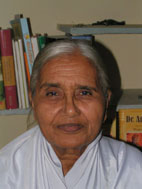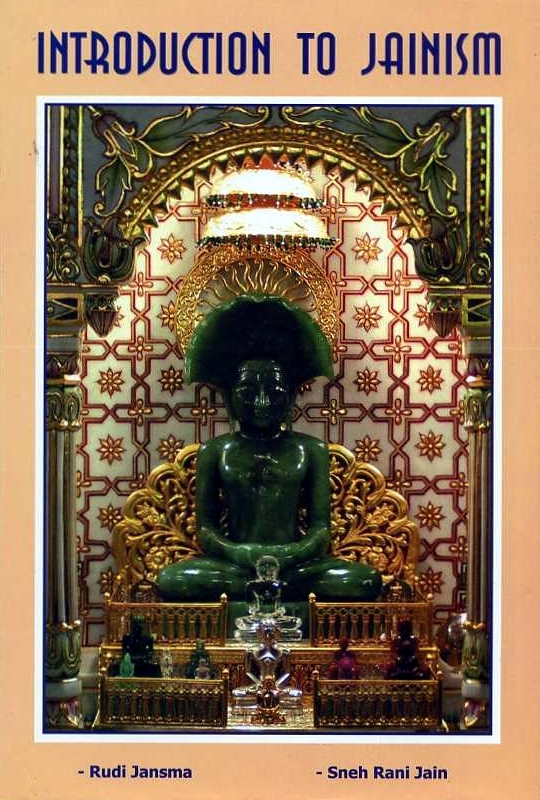Videha, the central continent of Jambūdvīpa, where we as inhabitants of Arya and Mleccha Khanda never travel, is described in detail in literature with its various mountains, lakes and rivers, its 32 provinces and as many capitals, each with its own king who, after a long existence in one or the four celestial realms of the celestial gods, have descended to earth to reign over their land as great leaders. The people of Videha can - unlike to us in the present dark age of ignorance, deception and misery - reach full liberation, and it is said that every day a number of them do so.
Mount Meru in the center of Videha consists of three cones on top of each other,[67] and is in total about one million kilometers high. There are three large terraces or mountain plateaus related to the three cones, on which forests grow and divine beings live. On top is a peak of beryllium with a sanctuary. At the foot of the mountain stretch four regions with eight mountains on which the guardians of the four cardinal directions reside. In these directions there are shrines of the Jinas, divine palaces, and lakes.
It will be clear that nobody has ever seen such a mountain with physical eyes, but that here again a mystical teaching must be hidden.[68] The Hindus as well, Buddhists, and even the Navahos in Arizona speak of such a mountain. The same applies to the Jambū tree, which - as in other cultures - is a symbol for the spiritual knowledge, which one acquires when one has climbed the path towards the top of Meru. The tree is described as consisting of jewels and precious metals only, and the fruits are as big as elephants - and they are immortality; in the tree the protection bird of all the dvīpas has its nest. In the four cardinal directions are the four guardians - which we encounter in some form in mythology all over the world.[69]
In Hindu literature it the cones are narrowest at the surface of the earth and that they become wider and wider both above and below the earth. The partly diabolical shape of the Jain universe also suggests that a magnetic “mountain” in a magnetic universe is meant rather than a physical continent
Because the central, round dvīpa, Jambūdvīpa, is encircled by saltwater and we live on it, and the other dvīpas which are unperceivable by the eye, have the same center point, namely Mount Meru, we may suppose that Jambūdvīpa refers to our earth. In modern Theosophical literature (The Secret Doctrine* and Fountain Source of Occultism**) we find commentaries on Mount Meru, which may provide a key to understanding the meaning (or one of the meanings) of the three cones of which it is composed. There we find, briefly summarized, three “floors” or stages which are the spiritual home of humanity. The “ground floor” is described as: “the beautiful and mysterious region of Śambhala [‘under which beats the heart of Mother earth’]; the next is the mythical north pole, geographically identical with the north pole of the earth, but mystically quite different; and the highest floor is the sun.” Not the sun we see with our eyes, but the spiritual heart of the solar system with which the earth is spiritually and magnetically connected. Perhaps this is what the original Jain Kevalins (Knowers) who had reached the highest stages of the “Path” meant when they spoke about the three “terraces” of Mount Meru where divine beings reside. “On these floors live three separate classes of entities, with all of which the human race is in strait spiritual and intellectual union.” When our inner substances separate themselves from our physical bodies and we travel through one or more of these regions, we first become great souls [mahātmas], “from mahātmahood we pass into quasi-divinity, and from quasi-divinity we become gods.” The Jains speak of ascetics who, after leaving their physical bodies, abide in the highest three levels of the universe: those who need to be reborn twice, those who need to be reborn only once, and those (the liberated ones or siddhas) who are no longer reborn at all. Once a man belongs to these higher classes of being he can choose to return to earth to fulfill a lofty, but often very inconspicuous task, say the Theosophists.
* Blavatsky, H.P.: The Secret Doctrine; The Synthesis of Science, Religion and philosophy, 2 Vols. Theosophical University Press, Pasadena CA, (1888) 2000/(Zirkoff, Boris de (ed)): The Secret Doctrine, The Theosophical Publishing House, Wheaton IL, 1993. ** Purucker, G. De: Fountain-Source of Occultism; A Modern Presentation of the Ancient Universal Wisdom based on The Secret Doctrine by H.P. Blavatsky, Theosophical University Press, Pasadena CA, 1974.
In this connection interesting hints can also be found in Theosophical literature. Blavatsky described in her Secret Doctrine that this refers to the protectors of mankind, who have control over a hierarchical “host of heavenly beings” who are the intelligent agents or executors of karma on earth. We are talking about spiritual beings who were themselves humans in the distant or relatively recent past, and now work actively as protectors and for the wellbeing of humankind. However, they cannot and are not allowed to protect humanity or individuals against their own karma - the self-created results of their actions. Karma is a universal law, and as long as there are causes on a particular level of conscious existence, there are results as well. It cannot be otherwise. No god, tīrthamkara or buddha can do anything about that. That is why the sages of all ages have always stimulated us to awaken spiritually and to live in harmony with life - jīva - on the basis of the wisdom thus acquired.
The protecting bird who lives in the Jambūtree of spiritual accomplishments guards the profane eating from the fruits they can not yet endure.
 Dr. Sneh Rani Jain
Dr. Sneh Rani Jain
 Publisher:
Publisher: